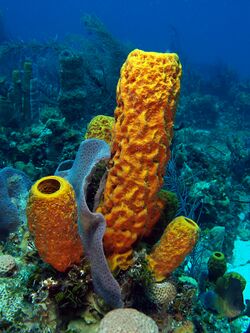Biology:Aplysina fistularis
| Aplysina fistularis | |
|---|---|

| |
| Scientific classification | |
| Domain: | Eukaryota |
| Kingdom: | Animalia |
| Phylum: | Porifera |
| Class: | Demospongiae |
| Order: | Verongida |
| Family: | Aplysinidae |
| Genus: | Aplysina |
| Species: | A. fistularis
|
| Binomial name | |
| Aplysina fistularis (Pallas, 1766)
| |
| Synonyms | |
|
List
| |
Aplysina fistularis (A. fistularis), also known as the yellow tube sponge,[1] is a species of sea sponge in the order Verongiida.[2] Aplysina fistularis is a golden or orange-brown color with a conulose surface. The animal is abundant in the Caribbean, where it is commonly found in reefs of open water areas.[1] This sponge was first described by the Prussian zoologist Peter Simon Pallas in 1766.
Description
Aplysina fistularis consists of one or more yellow tube-like structures that arise from a closed base and are sessile. The sponge has wide oscula and thin walls with ridged surfaces.[3] Each tube is rarely over 30 centimetres (12 in) in clear water but can reach 50 centimetres (20 in) in turbid-zone reefs. Unlike the related species Aplysina insularis, A. fistularis does not develop rope-like projections around its tubes, although it may show some branching tendrils.[4] A. fistularis does not have a silicate skeletal structure like most sponges, and was used as a bath sponge before the invention of synthetic sponges.[3]
The primary predator of A. fistularis is the hawksbill turtle.[3]
Reproduction
Aplysina fistularis can reproduce both sexually and asexually. Asexual reproduction usually occurs only if a piece of the body is broken off. Newly formed sponges require a hard surface to attach to and grow on. If a reef is heavily disturbed, such as being covered by algae or sediment, A. fistularis may struggle to establish itself and grow.[3]
In popular culture
In The SpongeBob Musical, the popular animated character SpongeBob SquarePants is revealed to be an Aplysina fistularis.[5]
References
- ↑ 1.0 1.1 "Yellow tube sponge (Aplysina fistularis)". Interactive Guide to Caribbean Diving. Marine Species Identification Portal. http://species-identification.org/species.php?species_group=caribbean_diving_guide&id=436. Retrieved 2012-10-15.
- ↑ "Aplysina fistularis (Pallas, 1766)". World Porifera database. World Register of Marine Species. 2022. http://www.marinespecies.org/aphia.php?p=taxdetails&id=169648.
- ↑ 3.0 3.1 3.2 3.3 "Yellow Tube Sponge" (in en-US). https://oceana.org/marine-life/yellow-tube-sponge/.
- ↑ "Aplysina fistularis". Coralpedia (University of Warwick). https://coralpedia.bio.warwick.ac.uk/en/sponges/aplysina_fistularis.
- ↑ Jarrow, Kyle (June 7, 2016). The SpongeBob Musical (Broadway musical). Tina Landau.
French Narrator: This fruit is home to one of the most fascinating sea creatures of all—Aplysina fistularis, the yellow sponge.
External links
Wikidata ☰ Q2539618 entry
 |

